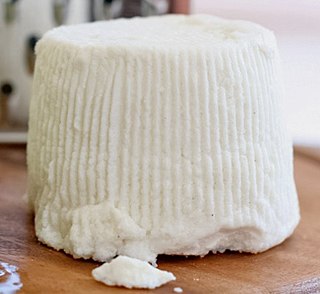Loading AI tools
Cheese made from the milk of goats From Wikipedia, the free encyclopedia
Goat cheese, goat's cheese or chèvre (/ˈʃɛv(rə)/ SHEV(-rə); from the French fromage de chèvre [fʁɔmaʒ də ʃɛvʁ] with the same meaning)[1] is cheese made from goat's milk. Goats were among the first animals to be domesticated for producing food.[2] Goat cheese is made around the world with a variety of recipes, giving many different styles of cheeses, from fresh and soft to aged and hard.[3]
This article needs additional citations for verification. (March 2011) |


Goats produce high-quality, nutrient-rich milk under even the most difficult environments, making them valuable to arid or mountainous areas where cattle and sheep cannot survive.[4] In addition, like all animal products, goat milk is heavily influenced by what the goats are eating. Because goats have hardy digestive systems, they tend to eat many bitter plants that more delicate animals such as cows and horses will not.[5] Goats were one of the earliest animals domesticated to suit human needs—more specifically milk production—going back to 8,000 BC, 10,000 years ago.[2] Goat cheese has been made for at least as far back as 5,000 BC;[6] the first documented proof of humans making cheese of any kind dates to 7,500 years ago in Poland.
Goat milk has higher proportions of medium-chain fatty acids, such as caproic and caprylic, which contribute to the characteristic tart/"goat" flavor of the cheese.[7] They also make goat milk and cheeses more easily digestible.[8]
Goat milk, and therefore goat cheeses, contain anti-inflammatory enzymes, probiotics, antioxidants, proteins, and lipids and help maintain a healthy metabolism. These fatty acids take their name from the Latin for 'goat', capra.[9] It is also high in calcium, vitamins A and K, phosphorus, thiamin, and niacin.[4] Overall, the consumption of 60 grams (2.1 oz) per day of cheese (both control and enriched), within the context of a balanced hypocaloric diet and recommendations for physical activity, was effective for the reduction of body weight, body mass index and waist circumference.[10]
Goat cheese is made like other cheeses. The milk is filtered to remove unwanted impurities or deposits. A curdling starter agent is added, which can be rennet, or one or more starter bacteria that affect the curds' size and eventually the cheese's consistency. Some examples of starters are Lactococcus lactis lactis, L. l. cremoris, and Streptococcus thermophilus. Next, the cheese is molded and separated from the whey (the uncurdled liquid part of the milk). The curds are then molded, dried, flavored, and cured. Any variations in this process—the type of starter, the time or pressure of the draining, the temperature and duration of the curing process—can change the texture (soft, semihard, hard) and the flavor.[11]



There are many different goat cheeses made in Denmark.

France produces a great number of goat milk cheeses, especially in the Loire Valley and Poitou.







Seamless Wikipedia browsing. On steroids.
Every time you click a link to Wikipedia, Wiktionary or Wikiquote in your browser's search results, it will show the modern Wikiwand interface.
Wikiwand extension is a five stars, simple, with minimum permission required to keep your browsing private, safe and transparent.